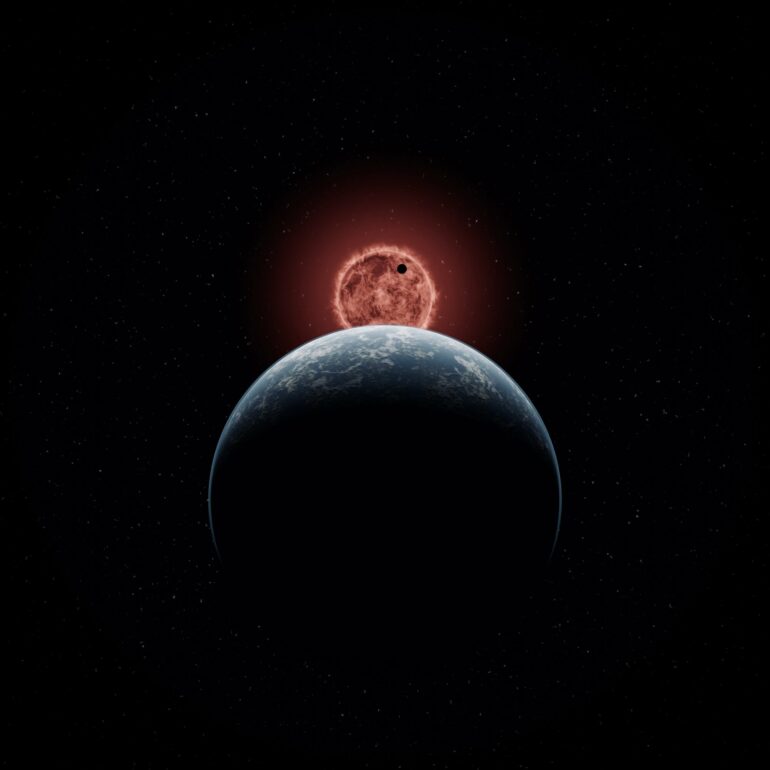A study led by researchers of the University of Liège and the CSIC—using observations from NASA’s TESS telescope—presents the detection of a system of two planets slightly larger than Earth orbiting a cold star in a synchronized dance. Named TOI-2096, the system is located 150 light-years from Earth.
The discovery is the result of a close collaboration between European and American universities and was made possible by the US space mission TESS (Transiting Exoplanet Survey Satellite), which aims to find planets orbiting nearby bright stars.
“TESS is conducting an all-sky survey using the transit method, that is, monitoring the stellar brightness of thousands of stars in the search for a slight dimming, which could be caused by a planet passing between the star and the observer. However, despite its power to detect new worlds, the TESS mission needs support from ground-based telescopes to confirm the planetary nature of the detected signals,” explains Francisco J. Pozuelos, astrophysicist, first author of the paper, former member of the ExoTIC laboratory at the Univeristy of Liège, and who has now joined the Spanish National Research Council (IAA-CSIC).
The planets TOI-2096 b and TOI-2096 c were observed with an international network of ground-based telescopes, allowing their confirmation and characterization. The majority of the transits were obtained with telescopes of the TRAPPIST and SPECULOOS projects led by the University of Liège.
“Making an exhaustive analysis of the data, we found that the two planets were in resonant orbits: for each orbit of the outer planet, the inner planet orbits the star twice,” says Mathilde Timmermans, a doctoral student at the ExoTIC lab at ULiège and second author of the paper published in the journal Astronomy & Astrophysics.
“Their periods are therefore very close to being a multiple of each other with about 3.12 days for planet b and about 6.38 days for planet c. This is a very particular configuration, and it causes a strong gravitational interaction between the planets. This interaction delays or accelerates the passage of the planets in front of their star and could lead to the measurement of the planetary masses using larger telescopes in the near future.”
The researchers behind the discovery estimate that the radius of planet b—the closest to its star—is 1.2 times that of Earth, hence the name ‘super-Earth’. Its properties could be similar to Earth’s: a planet with a mostly rocky composition, possibly surrounded by a thin atmosphere. Similarly, the radius of planet c is 1.9 times the radius of the Earth and 55% that of Neptune, which could place the planet in the category of ‘mini-Neptunes,’ planets composed of a rocky and icy core surrounded by extended hydrogen- or water-rich atmospheres, such as Uranus and Neptune in our solar system.
These sizes are very interesting because the number of planets with a radius between 1.5 and 2.5 Earth radii is smaller than what theoretical models predict, making these planets a rarity.
“These planets are of crucial importance given their sizes,” notes Mathilde Timmermans, “the formation of super-Earths and mini-Neptunes remains a mystery today. There are several formation models trying to explain it, but none fits the observations perfectly. TOI-2096 is the only system found to date that has a super-Earth and a mini-Neptune precisely at the sizes where the models contradict each other. In other words, TOI-2096 may be the system we’ve been looking for to understand how these planetary systems have formed.”
“Furthermore, these planets are among the best in their category to study their possible atmospheres,” explains Francisco J. Pozuelos.
“Thanks to the relative sizes of the planets with respect to the host star, as well as the brightness of the star, we find that this system is one of the best candidates for a detailed study of their atmosphere with the JWST space telescope. We hope to be able to do this quickly by coordinating with other universities and research centers. These studies will help confirm the presence of an atmosphere, extensive or not, around planets b and c and thus give us clues as to their formation mechanism.”
More information:
F. J. Pozuelos et al, A super-Earth and a mini-Neptune near the 2:1 MMR straddling the radius valley around the nearby mid-M dwarf TOI-2096, Astronomy & Astrophysics (2023). DOI: 10.1051/0004-6361/202245440
Provided by
University de Liege
Citation:
Astronomers discover a key planetary system for understanding formation mechanism of mysterious ‘super-Earths’ (2023, May 25)



